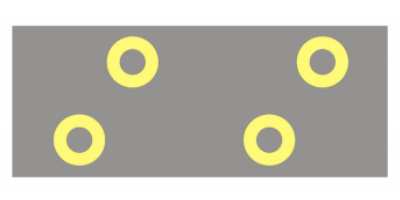Perch, Perca
fluviatilis, are
chiefly overtake-and-catch predators (like yellow perch, P. flavescens: Nursall, 1973). So, perch that pursue the lures cannot see any details in their front coloration.
The
main objective of these tests was to verify the effectiveness of spinning lures
with blades that had backside red spots.
Spinning
lures of two types, Mepps Aglia #1 with large red spots (7 mm diameter) on the backside of
silver blades (RB) (printed closer to the axis of rotation) and the same lures with
plain blades (PB), were compared in the field.
At each estimated locality of perch, 20 presentations (cast and retrieving) of lures were made: 5
with RB, 5 with PB, 5 with RB and 5 with PB. Then an experimentator moved to
the other locality, where 20 presentations of the compared lures were made in
the reverse order. In total, 180 lure presentatations per 1 day were made, 38 perch were included in the calculation (see Table,
null and equal results for RB and PB lures were canceled).
For
comparison, the number of landed perch were group per each 10 lure
presentations (140 lure presentations were included in the caculation).
Mepps Aglia #1
silver blade without spots
| Mepps Aglia #1
silver blade with backside red spots
|
3
| 4
|
0
| 5
|
2
| 3
|
1
| 4
|
0
| 2
|
3
| 5
|
2
| 4
|
Total number of landed perch
11
| Total number of landed perch
27
|
Mean number
per 10 lure presentations
1,57
| Mean number
per 10 lure presentations
3,86
|
Lures had the same cylindrical brass bodies with four circle grooves filled with the red paintPerch were released. Some landed
and released Northern pike, Esox lucius,
were no included in the calculation.
It seems
that lures with spotted blades are much more effective (on an average, 3,86
perch per 10 lure presentations) than lures with plain blades (1,57 perch). Really, an estimation of mean difference with the
assistance of Student’s t-test confirms this hypothesis (n1 = 7, n2
= 7, k =12, tfact > tstandard, P < 0,01): perch prefer
lures with spotted blades.
The same results were obtained within several sessions.
Spinners
with backside red spots are also effective for asp, Aspius aspius, chub, Leuciscus
cephalus, ide, L. idus,
and sabrefish, Pelecus cultratus, which usually pursue live prey and artificial lures like perch.
Basic References
...
Read more »





